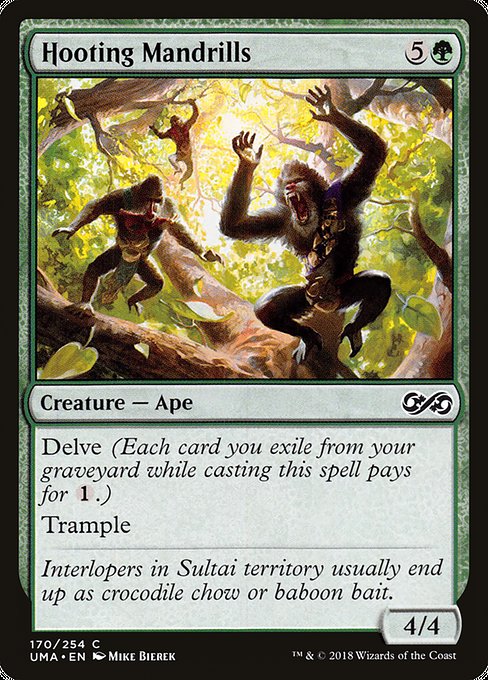
Image courtesy of Scryfall.com
Jungle Motifs, Masks, and the Sultai Whisper in MTG’s Hooting Mandrills
When you first lay eyes on Hooting Mandrills, you’re met with a riot of jungle energy and primal presence 🧙♂️🔥. The creature—a green ape with a commanding 4/4 body—belongs to Ultimate Masters, a reprint set that invites players to revisit classics with modern print quality. Its mana cost of {5}{G} sits squarely in green’s wheelhouse: big bodies that pressure the battlefield, often supported by a stream of cards from the graveyard thanks to Delve. And because it’s a common, it’s the kind of card you might encounter in a sleeve-staining pile at a casual commander table or as a surprising mid-game beater in a mono-green stompy shell. The art by Mike Bierek conveys more than just a creature; it conveys a cultural current that threads real-world wildlife imagery into a fantasy tapestry 🧭🎨.
Delve is the mechanic that gives Hooting Mandrills its edge. By exiling cards from your graveyard, you effectively pay for the giant’s cost by sacrificing your own history—your earlier battles and near-misses become the fuel for a ferocious charge. This is green’s core idea in action: transform the resources you’ve collected across the game into a decisive impact on the battlefield. Delve echoes a broader theme in MTG where knowledge of the past—your graveyard as a resource—can unlock a present-tense, brutal force. The Mandrills’ trample ensures that even if blockers appear, you’re pushing through value and creating face-down consequences for your opponent’s life total ⚔️💎.
“Interlopers in Sultai territory usually end up as crocodile chow or baboon bait.”
This flavorful line, tucked into the Mandrills’ flavor text, anchors the artwork in a specific cultural ecosystem—the Sultai clan’s lush, swampy territories from Tarkir lore—but it also resonates with broader ideas about outsiders and the fierce guardianship of ecological borders. The artwork doesn’t merely show a clever primate; it paints a mood—dense canopies, half-glimpsed predators, and a sense that every leaf could hide a story. The color palette leans into deep greens and earthy browns, with sharp highlights that recall traditional carving and textile motifs found across many African and Southeast Asian art traditions. The blend feels both ancient and immediate, a bridge between myth and a modern gameplay moment 🧙♂️🎲.
From a design perspective, Hooting Mandrills embodies a successful intersection of lore and mechanics. Its six-mana frame would seem prohibitive in another color pair, but green’s ramp and the Delve payoff deliver a satisfying tempo bump when the graveyard is ready. The 4/4 body is sturdy enough to stand up to early aggression, while Trample pushes through damage even when the board state is crowded with defenders. In multiplayer formats like Commander, this card shines as a flexible top-end threat that scales with the number of cards you’re willing to exile. It’s not about a flashy top-deck; it’s about turning the debt of your earlier turns into immediate, stomping payoff 💥⚔️.
Beyond gameplay, the art’s cultural influences invite us to consider how MTG artists draw from global visual languages. The Mandrills’ facial expressions and muscular form evoke masks and totems that appear in art from many regions, while the jungle setting nods to real-world ecosystems that inspire green decks—the idea that a thriving forest is a living, breathing force that can overwhelm an opponent as surely as any spell. Mike Bierek’s illustration captures movement and intention—the primate’s gaze, the tension in its limbs, the way light threads through the canopy—as if the viewer is stepping into a moment just before the Mandrill’s leap. It’s a reminder that the best MTG art doesn’t merely decorate a card; it tells a story and primes you for the moment you cast the spell 🧭🖼️.
For collectors and players alike, UMA’s reprint status adds another layer of appreciation. The card exists in both foil and nonfoil finishes, preserving its accessibility while offering glossy allure for those chasing rarity and shine. Even though Hooting Mandrills sits as a common rarity in this set, the artwork remains a standout particular—a vivid, characterful piece that embraces MTG’s tradition of blending natural wonder with mythical menace. In practical terms, you’re likely to find the Mandrills in casual builds that lean on ramp and mid-to-late-game pressure, where a single swing can flip a match from tense to triumphant. And when the greens in your deck align with a few Delve enablers, it’s easy to imagine the battlefield turning into a chaotic, joyful carnival of green energy 🧙♂️💚.
As you build around Hooting Mandrills, consider how its art speaks to a broader cultural reverence for wildlife and sacred spaces. The jungle doesn’t just backdrop battle; it shapes the character’s psychology—the Mandrills appear as guardians and aggressors, a symbol of the wild that MTG often uses to remind players that power comes from a deep, interconnected history of life in the green world 🎨🪵.
While you’re exploring this card’s vibe, you can also check out a few real-world sources that explore motion, choice, and dynamic design in games and art—topics that echo the spirit of the Mandrills’ own approach to strategy and style 🔥. And if you’re looking to refresh your desk or gaming setup, the Neon Gaming Mouse Pad Non-slip 9.5x8in Anti-Fray 1 offers a neon splash that literally glows like the mandrill’s wild gaze—perfect for users who love a little extra flair at the table. The synergy between vivid card art and vivid peripherals is a reminder that hobby ecosystems thrive on cross-pollination, from the battlefield to the workstation 🎮💎.
Neon Gaming Mouse Pad Non-slip 9.5x8in Anti-Fray 1More from our network
- https://crypto-acolytes.xyz/blog/post/precise-motion-reveals-hot-blue-giant-binary-dynamics/
- https://blog.zero-static.xyz/blog/post/top-warframe-alternatives-you-should-try-on-pc-and-consoles/
- https://crypto-acolytes.xyz/blog/post/elden-ring-vs-dark-souls-which-reigns-supreme/
- https://blog.rusty-articles.xyz/blog/post/todays-best-ipad-deals-save-on-256gb-ipad-a16/
- https://crypto-acolytes.xyz/blog/post/how-web3-is-transforming-live-streaming-for-creators/